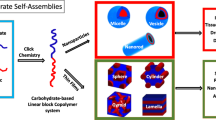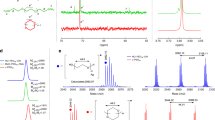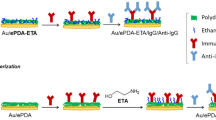Abstract
Alkanethiolates have been widely used as chemisorbates to modify gold surfaces, in spite of their relatively poor oxidative stability. We introduce gold-chemisorbing block copolymers bearing an anchoring block of poly(propylene sulphide) (PPS), selected in the expectation of greater stability. These materials offer a more robust approach to surface modification of gold. As an example, a triblock copolymer with poly(ethylene glycol) (PEG) was selected, with the goal of minimizing biological adsorption and adhesion. The copolymer PEG17-bl-PPS25-bl-PEG9 chemisorbed to form a dense monolayer of 226 ± 26 ng cm−2, ∼2.2 nm thick. The copolymeric adlayer was much more stable to oxidation than commonly used alkanethiolates. Its presence greatly reduced protein adsorption (>95%), even after exposure to whole blood serum (>55 mg ml−1), as well as cell adhesion over long culture durations (>97%). PPS-containing copolymers are an attractive alternative to alkanethiolates, and PEG-bl-PPS-bl-PEG presents a powerful example for use in biodiagnostic and bioanalytical devices.
This is a preview of subscription content, access via your institution
Access options
Subscribe to this journal
Receive 12 print issues and online access
$259.00 per year
only $21.58 per issue
Buy this article
- Purchase on Springer Link
- Instant access to full article PDF
Prices may be subject to local taxes which are calculated during checkout



Similar content being viewed by others
References
Mrksich, M. et al. Controlling cell attachment on contoured surfaces with self-assembled monolayers of alkanethiolates on gold. Proc. Natl Acad. Sci. USA 93, 10775–10778 (1996).
Mrksich, M., Dike, L.E., Tien, J., Ingber, D.E. & Whitesides, G.M. Using microcontact printing to pattern the attachment of mammalian cells to self-assembled monolayers of alkanethiolates on transparent films of gold and silver. Exp. Cell Res. 235, 305–313 (1997).
Nuzzo, R.G. & Allara, D.L. Adsorption of bifunctional organic disulfides on gold surfaces. J. Am. Chem. Soc. 105, 4481–4483 (1983).
Nuzzo, R.G., Zegarski, B.R. & Dubois, L.H. Fundamental-studies of the chemisorption of organosulfur compounds on Au(111)—implications for molecular self-assembly on gold surfaces. J. Am. Chem. Soc. 109, 733–740 (1987).
Bain, C.D. et al. Formation of monolayer films by the spontaneous assembly of organic thiols from solution onto gold. J. Am. Chem. Soc. 111, 321–335 (1989).
Porter, M.D., Bright, T.B., Allara, D.L. & Chidsey, C.E.D. Spontaneously organized molecular assemblies.4. Structural characterization of normal-alkyl thiol monolayers on gold by optical ellipsometry, infrared-spectroscopy, and electrochemistry. J. Am. Chem. Soc. 109, 3559–3568 (1987).
Chidsey, C.E.D., Liu, G.Y., Rowntree, P. & Scoles, G. Molecular order at the surface of an organic monolayer studied by low-energy helium diffraction. J. Chem. Phys. 91, 4421–4423 (1989).
Nuzzo, R.G., Dubois, L.H. & Allara, D.L. Fundamental-studies of microscopic wetting on organic-surfaces.1. Formation and structural characterization of a self- consistent series of polyfunctional organic monolayers. J. Am. Chem. Soc. 112, 558–569 (1990).
Whitesides, G.M. & Laibinis, P.E. Wet chemical approaches to the characterization of organic- surfaces - self-assembled monolayers, wetting, and the physical organic-chemistry of the solid liquid interface. Langmuir 6, 87–96 (1990).
Laibinis, P.E. et al. Comparison of the structures and wetting properties of self- assembled monolayers of normal-alkanethiols on the coinage metal-surfaces, Cu, Ag, Au. J. Am. Chem. Soc. 113, 7152–7167 (1991).
Schreiber, F. Structure and growth of self-assembling monolayers. Prog. Surf. Sci. 65, 151–256 (2000).
Abbott, N.L., Folkers, J.P. & Whitesides, G.M. Manipulation of the wettability of surfaces on the 0.1-micrometer to 1-micrometer scale through micromachining and molecular self-assembly. Science 257, 1380–1382 (1992).
Kumar, A. & Whitesides, G.M. Features of gold having micrometer to centimeter dimensions can be formed through a combination of stamping with an elastomeric stamp and an alkanethiol ink followed by chemical etching. Appl. Phys. Lett. 63, 2002–2004 (1993).
Wilbur, J.L., Kumar, A., Biebuyck, H.A., Kim, E. & Whitesides, G.M. Microcontact printing of self-assembled monolayers: Applications in microfabrication. Nanotechnology 7, 452–457 (1996).
Libioulle, L., Bietsch, A., Schmid, H., Michel, B. & Delamarche, E. Contact-inking stamps for microcontact printing of alkanethiols on gold. Langmuir 15, 300–304 (1999).
Gorman, C.B., Biebuyck, H.A. & Whitesides, G.M. Fabrication of patterned, electrically conducting polypyrrole using a self-assembled monolayer—a route to all-organic circuits. Chem. Mater. 7, 526–529 (1995).
Huck, W.T.S., Yan, L., Stroock, A., Haag, R. & Whitesides, G.M. Patterned polymer multilayers as etch resists. Langmuir 15, 6862–6867 (1999).
Bishop, A.R. & Nuzzo, R.G. Self-assembled monolayers: Recent developments and applications. Curr. Opin. Colloid Interface Sci. 1, 127–136 (1996).
Singhvi, R. et al. Engineering cell-shape and function. Science 264, 696–698 (1994).
Pale-Grosdemange, C., Simon, E.S., Prime, K.L. & Whitesides, G.M. Formation of self-assembled monolayers by chemisorption of derivatives of oligo(ethylene glycol) of structure HS(CH2)11(OCH2CH2)meta-OH on gold. J. Am. Chem. Soc. 113, 12–20 (1991).
Harder, P., Grunze, M., Dahint, R., Whitesides, G.M. & Laibinis, P.E. Molecular conformation in oligo(ethylene glycol)-terminated self-assembled monolayers on gold and silver surfaces determines their ability to resist protein adsorption. J. Phys. Chem. B 102, 426–436 (1998).
Benesch, J. et al. Protein adsorption to oligo(ethylene glycol) self-assembled monolayers: Experiments with fibrinogen, heparinized plasma, and serum. J. Biomater. Sci. Polym. Edn 12, 581–597 (2001).
Bieri, C., Ernst, O.P., Heyse, S., Hofmann, K.P. & Vogel, H. Micropatterned immobilization of a G protein-coupled receptor and direct detection of G protein activation. Nature Biotechnol. 17, 1105–1108 (1999).
Terrettaz, S., Stora, T., Duschl, C. & Vogel, H. Protein-binding to supported lipid-membranes - investigation of the cholera-toxin ganglioside interaction by simultaneous impedance spectroscopy and surface-plasmon resonance. Langmuir 9, 1361–1369 (1993).
Tam-Chang, S.W., Biebuyck, H.A., Whitesides, G.M., Jeon, N. & Nuzzo, R.G. Self-assembled monolayers on gold generated from alkanethiols with the structure RNHCOCH2SH. Langmuir 11, 4371–4382 (1995).
Tarlov, M.J. & Newman, J.G. Static secondary ion mass-spectrometry of self-assembled alkanethiol monolayers on gold. Langmuir 8, 1398–1405 (1992).
Li, Y.Z., Huang, J.Y., McIver, R.T. & Hemminger, J.C. Characterization of thiol self-assembled films by laser desorption Fourier-transform mass-spectrometry. J. Am. Chem. Soc. 114, 2428–2432 (1992).
Cooper, E. & Leggett, G.J. Static secondary ion mass spectrometry studies of self- assembled monolayers: Influence of adsorbate chain length and terminal functional group on rates of photooxidation of alkanethiols on gold. Langmuir 14, 4795–4801 (1998).
Castner, D.G., Hinds, K. & Grainger, D.W. X-ray photoelectron spectroscopy sulfur 2p study of organic thiol and disulfide binding interactions with gold surfaces. Langmuir 12, 5083–5086 (1996).
Schoenfisch, M.H. & Pemberton, J.E. Air stability of alkanethiol self-assembled monolayers on silver and gold surfaces. J. Am. Chem. Soc. 120, 4502–4513 (1998).
Abuchowski, A., McCoy, J.R., Palczuk, N.C., Vanes, T. & Davis, F.F. Effect of covalent attachment of polyethylene-glycol on immunogenicity and circulating life of bovine liver catalase. J. Biol. Chem. 252, 3582–3586 (1977).
Amiji, M. & Park, K. Prevention of protein adsorption and platelet-adhesion on surfaces by PEO PPO PEO triblock copolymers. Biomaterials 13, 682–692 (1992).
Hoffman, A.S. Hydrogels for biomedical applications. Adv. Drug Deliv. Rev. 54, 3–12 (2002).
Neff, J.A., Tresco, P.A. & Caldwell, K.D. Surface modification for controlled studies of cell-ligand interactions. Biomaterials 20, 2377–2393 (1999).
Napoli, A., Tirelli, N., Kilcher, G. & Hubbell, J.A. New synthetic methodologies for amphiphilic multiblock copolymers of ethylene glycol and propylene sulfide. Macromolecules 34, 8913–8917 (2001).
Huang, N.P. et al. Poly(l-lysine)-g-poly(ethylene glycol) layers on metal oxide surfaces: Surface-analytical characterization and resistance to serum and fibrinogen adsorption. Langmuir 17, 489–498 (2001).
Jeon, S.I., Lee, J.H., Andrade, J.D. & de Gennes, P.G. Protein surface interactions in the presence of polyethylene oxide.1. Simplified theory. J. Colloid Interface Sci. 142, 149–158 (1991).
Acknowledgements
This work was supported in part by a grant from the Swiss Commission for Technology and Innovation to M.T. and J.A.H. and a grant from the Swiss Top Nano21 program (project Nanocontainers) to H.V. Part of this work was performed under the auspices of the US Department of Energy by Lawrence Livermore National Laboratory under contract W-7405-Eng.48. We thank C. Orme, C. Evans and A. Nelson for assistance with the XPS acquisition, A. Christian and J. Montgomery for the rat fibroblasts, and B. Cheung for the PDMS microfluidic channels.
Author information
Authors and Affiliations
Corresponding author
Ethics declarations
Competing interests
The authors declare no competing financial interests.
Supplementary information
41563_2003_BFnmat851_MOESM1_ESM.pdf
Chemisorbed Poly(propylene sulfide)-based Copolymers for chemisorption on gold surfaces to resist biomolecular interactions (PDF 21 kb)
Rights and permissions
About this article
Cite this article
Bearinger, J., Terrettaz, S., Michel, R. et al. Chemisorbed poly(propylene sulphide)-based copolymers resist biomolecular interactions. Nature Mater 2, 259–264 (2003). https://doi.org/10.1038/nmat851
Received:
Accepted:
Published:
Issue Date:
DOI: https://doi.org/10.1038/nmat851
This article is cited by
-
Point-of-care antimicrobial coating protects orthopaedic implants from bacterial challenge
Nature Communications (2021)
-
Recent Progress on COS-derived Polymers
Chinese Journal of Polymer Science (2019)
-
Effective poly(ethylene glycol) methyl ether grafting technique onto Nylon 6 surface to achieve resistance against pathogenic bacteria Staphylococcus aureus and Pseudomonas aeruginosa
Journal of Materials Science (2018)
-
Engineering cancer vaccines using stimuli-responsive biomaterials
Nano Research (2018)
-
High-performance asymmetrical supercapacitor composed of rGO-enveloped nickel phosphite hollow spheres and N/S co-doped rGO aerogel
Nano Research (2018)



